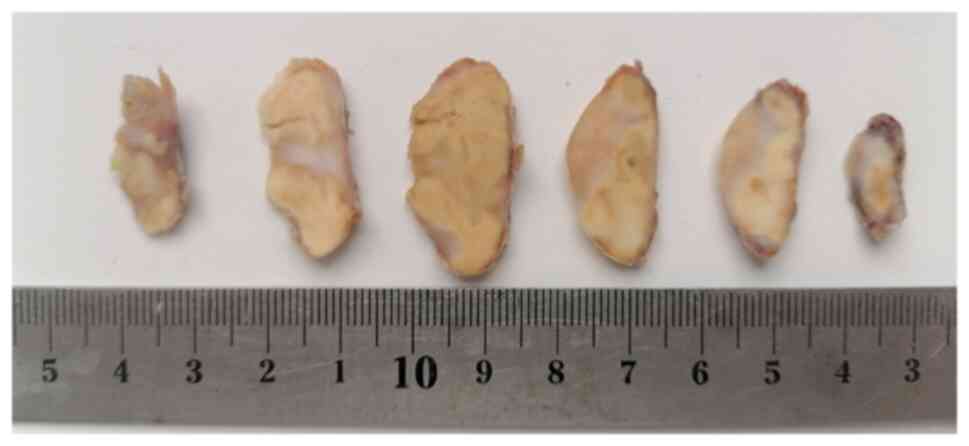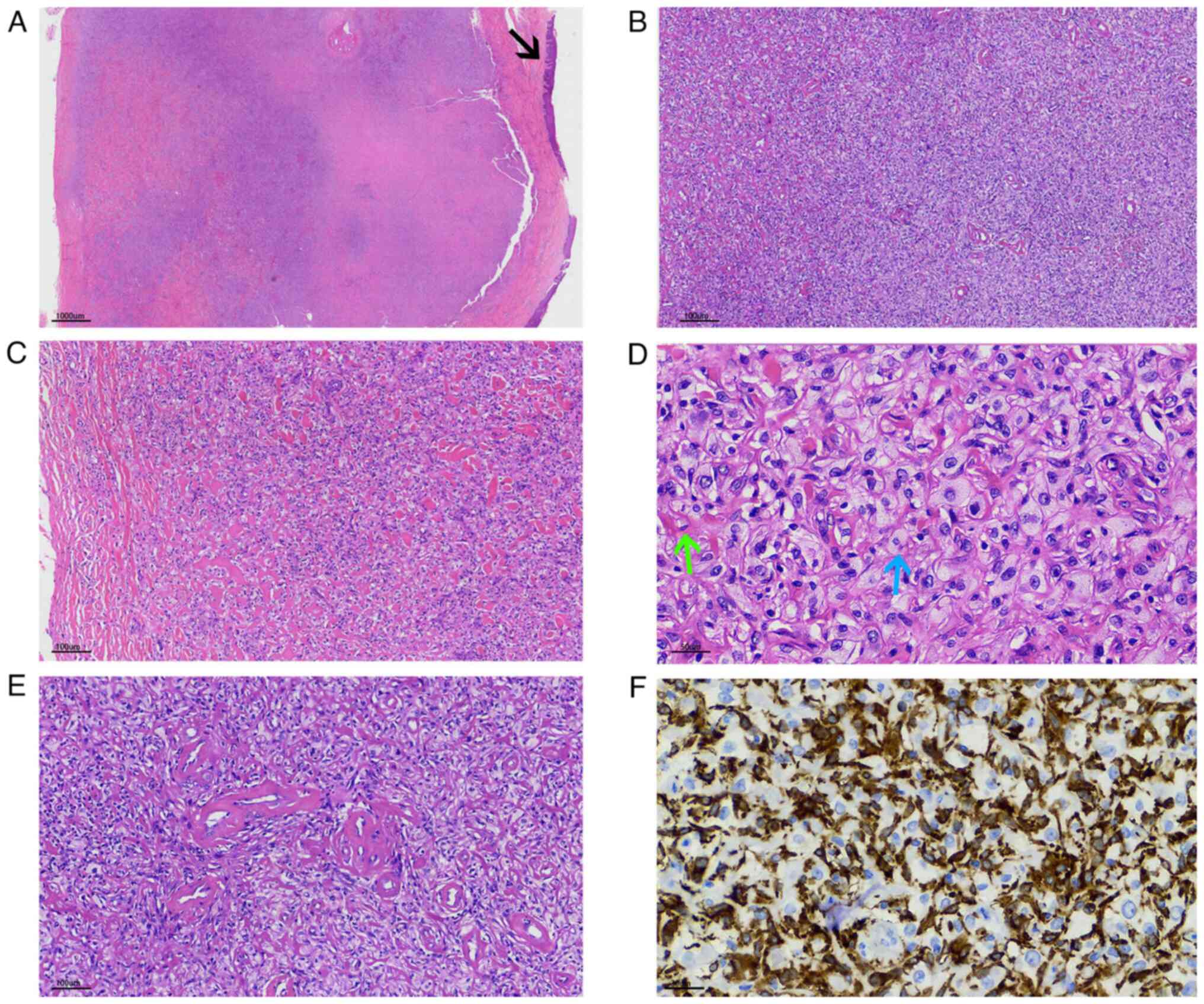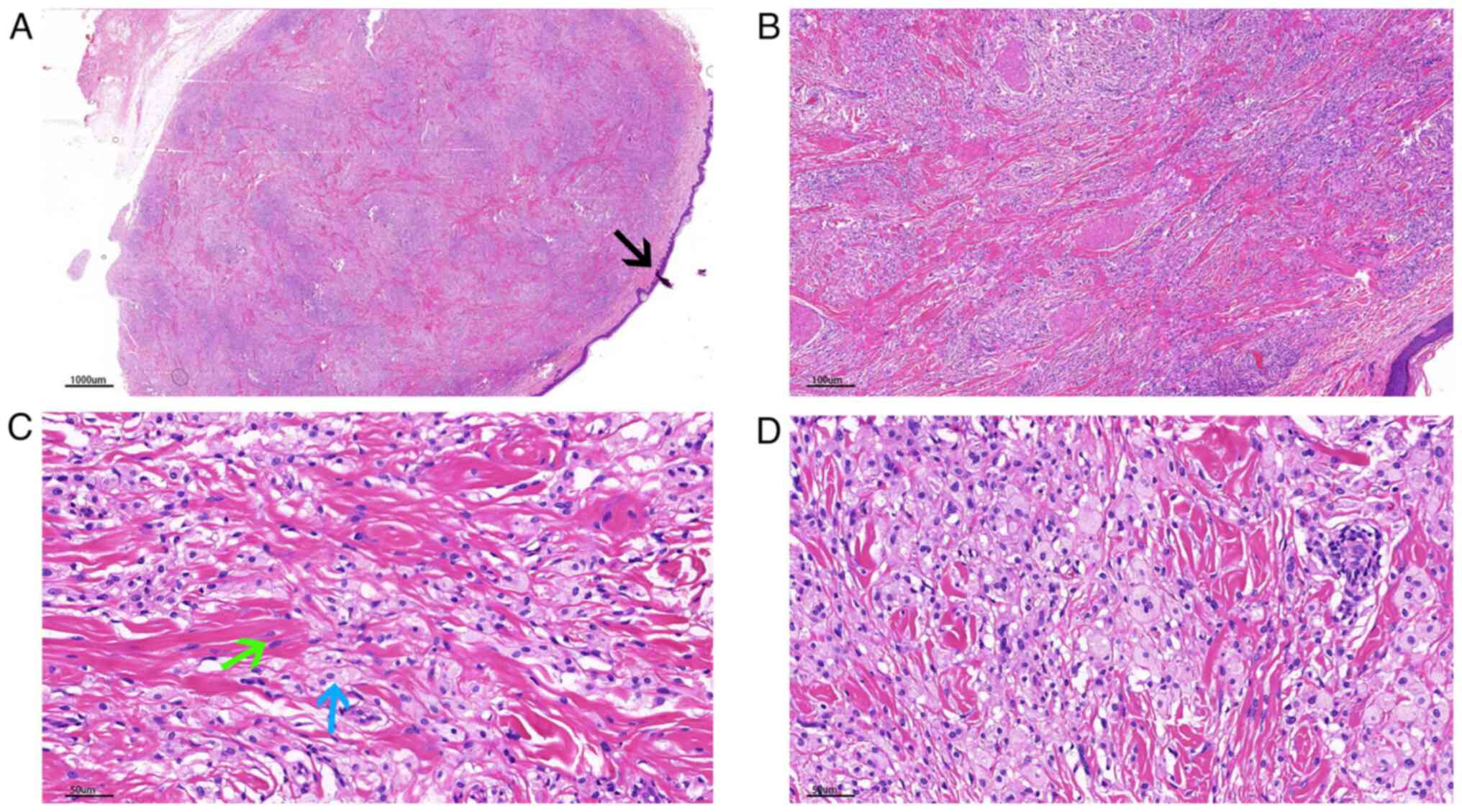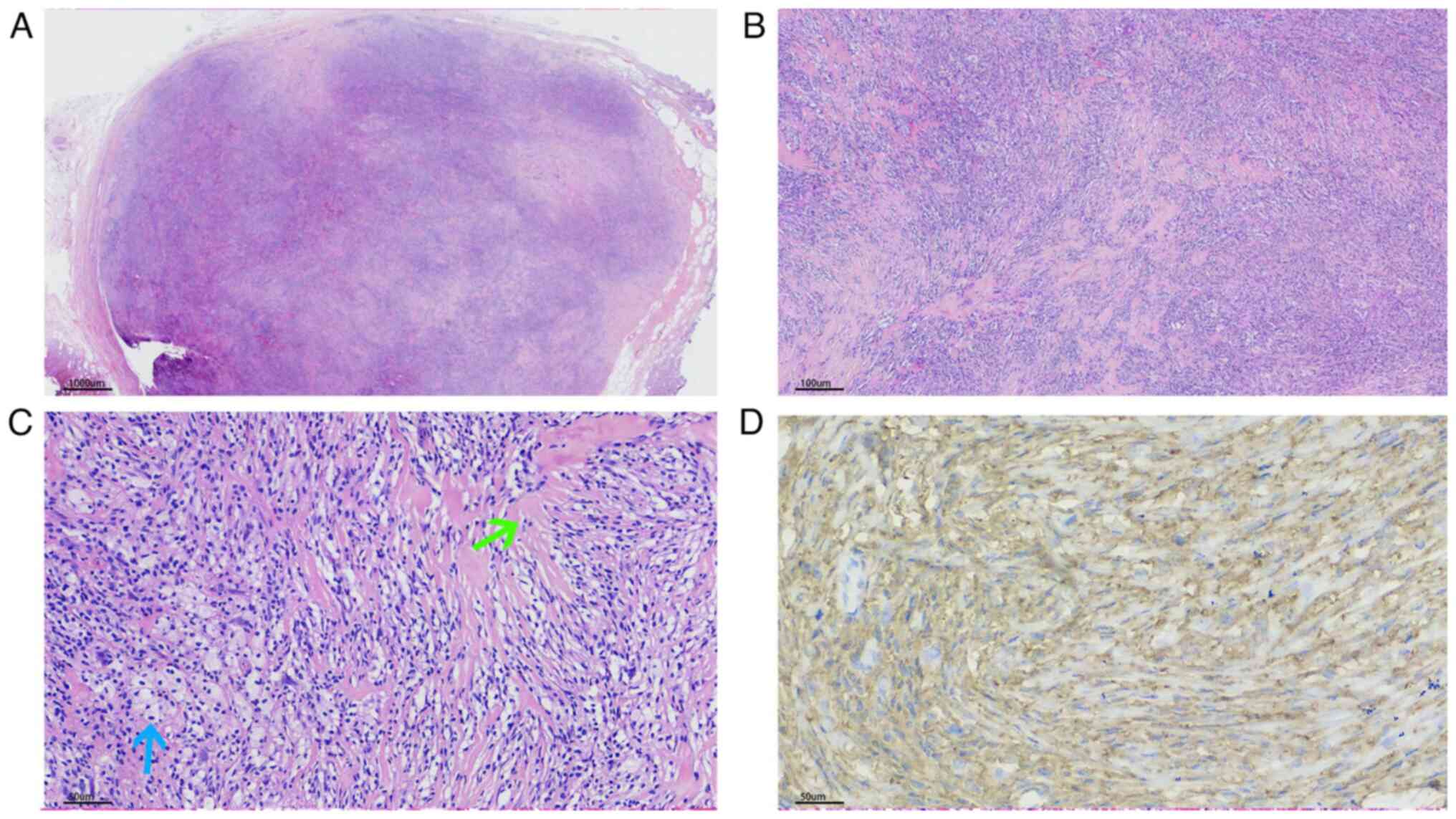Clinical and pathological studies of eight cases of lipidized fibrous histiocytoma
- Authors:
- Published online on: January 9, 2023 https://doi.org/10.3892/etm.2023.11792
- Article Number: 93
-
Copyright: © Liu et al. This is an open access article distributed under the terms of Creative Commons Attribution License.
Abstract
Introduction
Benign fibrous histiocytoma (FH), also known as dermatofibroma, is one of the most common benign tumors of the skin worldwide (1). It includes a group of mesenchymal lesions comprised of fibroblasts, histiocytes and myofibroblasts (1-3). It most often occurs on the extremities of middle-aged adults and is slightly more common in females compared with males (4). There are numerous clinicopathologic variants of FH, including benign cellular, aneurysmal, epithelioid cell, atypical, deep penetrating, granular cell and lipidized FH (3,4).
By definition, lipidized FHs consist of abundant lipid-laden histiocytes and distinctive stromal hyalinization (4). Lipidized FH most commonly develops in the lower limbs; thus, it is previously referred to as ‘ankle-type’ FH. Clinically, in comparison with other FH variants, it appears as a large exophytic yellow nodule surrounding the ankle (3-5). Lipidized FH is often misdiagnosed as other benign and malignant tumors (Liu et al, unpublished data). In our three pathology departments [Fenlan Laboratory (Hangzhou, China); Yexian First People's Hospital (Pingdinghan, China); People's Liberation Army 989 Hospital (Pingdingshan, China)], cases with marked stromal hyalinization and inconspicuous histiocytes are presented, which could be mistaken for other tumor types, such as sclerosing epithelioid fibrosarcoma. Thus, eight cases of lipidized FH were collected for use in the present study, and the pathological and clinical features were determined and the immunostaining were carried out for subsequent differentiation from other similar tumors.
Materials and methods
Patients
Clinical data were collected from the medical records of eight patients diagnosed with lipidized FH from November 2019 to November 2021. The diagnosis was confirmed by Dr Zhao Ming (Zhejiang Provincial People's Hospital, People's Hospital of Hangzhou Medical College, Hangzhou, China). A total of three cases originated from the tissue bank of the Department of Pathology of the Peoples' Liberation Army 989 Hospital (Pingdingshan, China), four cases originated from the tissue bank of Fenlan Medical Laboratory (Hangzhou, China) and one case originated from the tissue bank of Department of Pathology of Yexian People's Hospital (Pingdingshan, China). The cohort included three male and five female patients (male: female ratio, 1.7:1) with a mean age of 48 years (range: 38-62 years). The present study was approved by the 989 Hospital Medical Ethics Committee, Fenlan Lab Medical Ethics Committee and Yexian First People's Hospital Committee. All participants signed an informed consent form and all patient data were anonymized. The inclusion criterion was a diagnosis in accordance with lipidized FH.
Tissue preparation
Hematoxylin and eosin-stained slides were available for all cases and this staining was conducted using a method described by Sommer et al (6). The surgical specimens were fixed in 10% neutral buffered formalin in the room temperature, dehydrated in graded alcohol solutions and embedded in paraffin. Specimens were cut into 4-µm-thick sections for hematoxylin and eosin staining and visualization was carried out using light microscopy.
Immunohistochemistry
Sections (4-µm) from paraffin blocks were also stained immunohistochemically using BOND-MAX Automated IHC/ISH Stainer (Leica Microsystems GmbH). Sections were mounted onto slides, air dried for 20 min and baked at 60˚C for 20 min. The heat-induced antigen retrieval method was performed using Tris-EDTA buffer (1X; cat. no. #K0071; Shanghai Jiehao Biotechnology Co., Ltd.) and endogenous peroxidase activity usually responsible for background staining, was quenched with 3% peroxidase-blocking reagent, (Henan Celnovte Biotechnology Co., Ltd.), which was applied at 37˚C for 10 min. The slides were incubated with the following commercially available antibodies: CD68 (cat. no. CCR-0702; KP1; 1:1,000), smooth muscle actin (cat. no. CAM-0190; IA4; 1:50), S-100 protein (cat. no. CSM-0101; polyclonal; 1:500), CD34 (cat. no. CCM-0550; QBend10; 1:50), desmin (cat. no. CDM-0021; D33; 1:50), MUC4 (cat. no. CMM-0270; 8G7; 1:50) and cytokeratin (cat. no. CCM-0960; AE1/AE3; 1:50) at 37˚C for 30 min. All antibodies were purchased from Henan Celnovte Biotechnology Co., Ltd. The sections were then examined using a light microscope. Tissue sections were then washed (2x6 min) and incubated with Microstacker™ + Linker in room temperature for 15 min for signal amplification. After TBS washing (2x6 min), Microstacker™ Flex HRP-polymer detection reagent (ready-to-use; cat. no. #SD5100; mouse/rabbit linker; Celnovte Biotechnology Co., Ltd) was applied for at 37˚C for 30 min. After incubation with the polymer reagent, tissue sections were thoroughly washed with TBS buffer (3x6 min) and incubated with Microstacker™ DAB + Chromogen at 37˚C for 6 min. Slides were buffer washed (2x6 min), counterstained with hematoxylin at 37˚C for 2 min and washed with TBS and dH2O for 6 min respectively. Ultimately, dehydration through graded ethanol solutions as well as 90% xylene was performed and sections were mounted in synthetic resin and were observed under a light microscope.
The IHC results were scored by two independent observers according to the percentage of positively stained cells (0+, 1-25% staining; 1+, 26-50% staining; 2+, 51-75% staining; 3+, 76-100% staining).
Results
Clinical findings
The patient cohort included three males and five females with a mean age of 48 years (range, 38-62) at the time of diagnosis (Table I). Clinical symptoms were recorded in all eight cases. All patients reported the presence of a mass with no other complications. The preoperative duration ranged from 11 months to 6 years. All eight cases were followed up. None of these tumors had recurred locally at 6 to 24 months (median, 13.6 months) after the operation. No cases exhibited a history of hypertension, diabetes or hyperlipemia. A total of three tumors were located on the right buttock, one on the left buttock, one on the left lower leg, one on the right lower leg, one on the right shin and one on the left forearm.
Macroscopic pathological features
Grossly, all cases demonstrated a well-demarcated lesion, and lesions were elevated. The average tumor diameter was 21 mm (range, 7-35 mm). The cut surface of the lesions was yellow with parts that were white (Fig. 1).
Microscopic pathological features
There were solitary nodules in the reticular dermis. The nodules were well circumscribed; however, no fibrous or capsule-like membrane was revealed (Figs. 2A, 3A and 4A). The nodules were comprised of two markedly different components: Proliferating eosinophilic fibroblasts and lipid-laden histiocytes. In the majority of areas, the fibroblasts exhibited no cytologic atypia, with elongated nuclei, fine chromatin and small basophilic nucleoli. However, nuclear pleomorphism was present in the deep or peripheral area. Notably, no pathological mitotic figures were observed. The fibroblasts were arranged in a storiform pattern or with intersecting fascicles forming a loose lattice pattern (Figs. 2B, 2C, 3B and 4B). The histiocytes were oval to polygonal in shape with large hypochromatic nuclei, prominent nucleoli and abundantly vacuolated cytoplasm (Figs. 2D, 3C and 4C). In the majority of areas, histiocytes were combined with proliferating eosinophilic fibroblasts. There were also a number of binucleated or multinucleated Touton-type giant cells (Fig. 3D). Notably, there was marked stromal hyalinization, which was observed in >90% of the tumor area (Figs. 2C, 3B and 4C). Hyalinized collagen fibers transmigrated with normal collagen fibers (Fig. 2E), and the hyalinized materials exhibited different colors in microscopy; notably, certain areas presented as bright red and others presented as dull red (Figs. 2A, 3A and 4A). The bright red areas were rich in lipid-laden histiocytes and the dull red areas possessed fewer lipid-laden histiocytes. There were prominent hyalinized vessels in some cases (Fig. 2E). The epidermis exhibited hyperplasia, irregular elongation of the rete ridge, and basal pigmentation (Figs. 2A and 3A).
Immunohistochemical staining was positive for CD68 (Figs. 2F and 4D), focally positive for CD34, particularly in the peripheral region of the lesion, and negative for S-100 protein, smooth muscle actin, desmin, MUC4 and cytokeratin. These histopathologic findings led to the diagnosis of lipidized FH.
Discussion
Lipidized FH represents a small fraction of dermatofibromas (2%) (5,7). Iwata and Fletcher (4) observed that patients with lipidized FH have an increased age (mean, 54.8 years) compared with those with ordinary FH (third to fifth decades). Wagamon et al (8) reported that the ages in the lipidized FH group ranges from 35 to 75 years with a mean value of 53 years, whereas ages in the non-lipidized FH group ranges from 27 to 72 years with a mean value of 48 years (8). In the cohort of the present study, ages ranged from 38 to 62 years (mean, 48 years), which was consistent with the results obtained by Zaballos et al (7).
Moreover, Iwata and Fletcher (4) recommends the alternative name ‘ankle-type’ FH. However, Zaballos et al (7) observed five lesions located on the back, four lesions on the legs, three lesions on the arms and one lesion on the abdomen. Results of an alternate previous study demonstrated that lipidized FH does not differ clinically from non-lipidized FH in tumor location (8). In the present study, three tumors were located on the right buttock, one on the left buttock, one on the left lower leg, one on the right lower leg, one on the right shin and one on the left forearm, indicating that lipidized FH was not concentrated in the lower limbs.
Lipidized FH often presents with an increased size compared with common FH (4,7,8). The size of lipidized FH, with a median of 25 mm (and a range up to 80 mm) at the greatest dimension, is notably larger compared with ordinary FH (4). Results of the present study indicated that the average diameter of the tumor was 21 mm (range, 7-35 mm). Following sectioning, the majority of the cases in the present study were yellow in color, which is indicative of the presence of abundant foamy histiocytes with few fibroblasts or stromal hyalinization. In certain areas, the cut surface was yellow mixed with white. Moreover, under microscopic examination, the white area presented with abundant hyalinization.
Histological diagnostic criteria for lipidized FH are as follows: Over 75% of the area is occupied by foamy cells and stromal hyalinization (3,5), the majority of lesions are moderately vascularized and exhibit perivascular hyalinization and the fibroblasts are arranged in a storiform pattern (4,5). In the cohort of the present study, the tumor exhibited two extremities. In case 2 and case 3, the most dominant features were prominent stromal hyalinization, hyalinized vessels and lipid-laden histiocytes. The hyalinized materials exhibited two different colors under the microscope; certain areas presented as bright red and other areas presented as dull red. The bright red areas were rich in lipid-laden histiocytes and the dull red areas exhibited fewer lipid-laden histiocytes. This phenomenon may be associated with the different processes of the disease, such as myositis ossificans. Hyalinized collagen fibers transmigrated with normal collagen fibers in certain areas. These results indicated that the hyalinized materials may have taken place of the previous normal collagen fibers. In these cases, lipidized FH should therefore be distinguished from other malignant tumors, such as sclerosing epithelioid fibrosarcoma (SEF), particularly with marked stromal hyalinization and inconspicuous histiocytes (9). SEF is a rare, malignant mesenchymal tumor with unique features consisting of cords, nests or sheets of monotonous epithelioid cells within a dense collagenous background (9). SEF also has prominent hyalinized sclerotic collagenous stroma indicative of osteoids or cartilage, as in lipidized FH (9).
However, in patients 5 and 8, the tumors exhibited scant stromal hyalinization and prominent lipid-laden histiocytes. In these cases, lipidized FH should also be differentiated from other benign tumors, such as xanthoma (1,3,4). Xanthoma is a histiocytic proliferation that frequently occurs in association with hyperlipidemia, and occurs in tendons or bursae (10). It often contains cholesterol crystals and lacks a fibroblastic myofibroblastic neoplastic component (10).
In conclusion, lipidized have a wide spectrum. Some cases show the prominent stromal hyalinization, hyalinized vessels and lipid-laden histiocytes, and should be differentiated from the malignant tumors, such as sclerosing epithelioid fibrosarcoma. However, some cases exhibit the prominent lipid-laden histiocytes and scant stromal hyalinization and should be differentiated from the xanthoma. The present study was limited by relative infrequency of lipidized FH and limiting the number of patients in this cohort. Future studies should focus on the microenvironment in different areas of the lipidized FH.
Acknowledgements
Not applicable.
Funding
Funding: No funding was received.
Availability of data and materials
The datasets used and/or analyzed during the current study are available from the corresponding author on reasonable request.
Authors' contributions
CYL designed the study. FYL and HJW recruited the cases. CYL, FYL, HJW and GYW analyzed the experimental data and composed all figures and tables. CYL wrote the manuscript. FYL and HJW confirm the authenticity of all the raw data. All authors read and approved the final manuscript.
Ethics approval and consent to participate
The present study was approved by the 989 Hospital Medical Ethics Committee, Fenlan Lab Medical Ethics Committee and Yexian First People's Hospital Committee. Written informed consent was obtained at the time of the initial data collection for participation.
Patient consent for publication
All patients consented for publication in written form.
Competing interests
The authors declare that they have no competing interests.
References
|
Meister P, Konrad E and Krauss F: Fibrous histiocytoma: A histological and statistical analysis of 155 cases. Pathol Res Pract. 162:361–379. 1978.PubMed/NCBI View Article : Google Scholar | |
|
Gonzalez S and Duarte I: Benign fibrous histiocytoma of the skin. A morphologic study of 290 cases. Pathol Res Pract. 174:379–391. 1982.PubMed/NCBI View Article : Google Scholar | |
|
Seo JK, Shin EJ, Jeong KH and Shin MK: Lipidized fibrous histiocytoma: Differential diagnosis from juvenile xanthogranuloma. Ann Dermatol. 31:254–256. 2019.PubMed/NCBI View Article : Google Scholar | |
|
Iwata J and Fletcher CD: Lipidized fibrous histiocytoma: Clinicopathologic analysis of 22 cases. Am J Dermatopathol. 22:126–134. 2000.PubMed/NCBI View Article : Google Scholar | |
|
Alves JV, Matos DM, Barreiros HF and Bártolo EA: Variants of dermatofibroma-a histopathological study. An Bras Dermatol. 89:472–477. 2014.PubMed/NCBI View Article : Google Scholar | |
|
Sommer W, Knöfel AK, Izykowski N, Oldhafer F, Avsar M, Jonigk D, Warnecke G and Haverich A: Physical exercise reduces transplant arteriosclerosis in a mouse aorta transplantation model. J Thorac Cardiovasc Surg. 149:330–337. 2015.PubMed/NCBI View Article : Google Scholar | |
|
Zaballos P, Mir-Bonafé JF, Avilés JA and Bañuls J: Dermoscopy of lipidised dermatofibroma: A morphological study of 13 cases. Aus J Dermatopathol. 60:e127–e131. 2019.PubMed/NCBI View Article : Google Scholar | |
|
Wagamon K, Somach SC, Bass J, Sigel JE, Xue W, Schluchter M and Jaworsky C: Lipidized dermatofibromas and their relationship to serum lipids. J Am Acad Dermatol. 54:494–498. 2006.PubMed/NCBI View Article : Google Scholar | |
|
Kosemehmetoglu K, Ardic F, Kilpatrick SE, Aydingoz U, Sumathi VP and Michal M: Sclerosing epithelioid fibrosarcoma of bone: morphological, immunophenotypical, and molecular findings of 9 cases. Virchows Arch. 478:767–777. 2021.PubMed/NCBI View Article : Google Scholar | |
|
Wilkinson PE, Merkourea S, Gopalakrishnan R and Argyris PP: Primary intraosseous xanthomas of the jaws: A series of six cases including an example with formation of apoptosis-related hyaline globules, so-called ‘thanatosomes’. Head Neck Pathol. 14:859–868. 2020.PubMed/NCBI View Article : Google Scholar |













